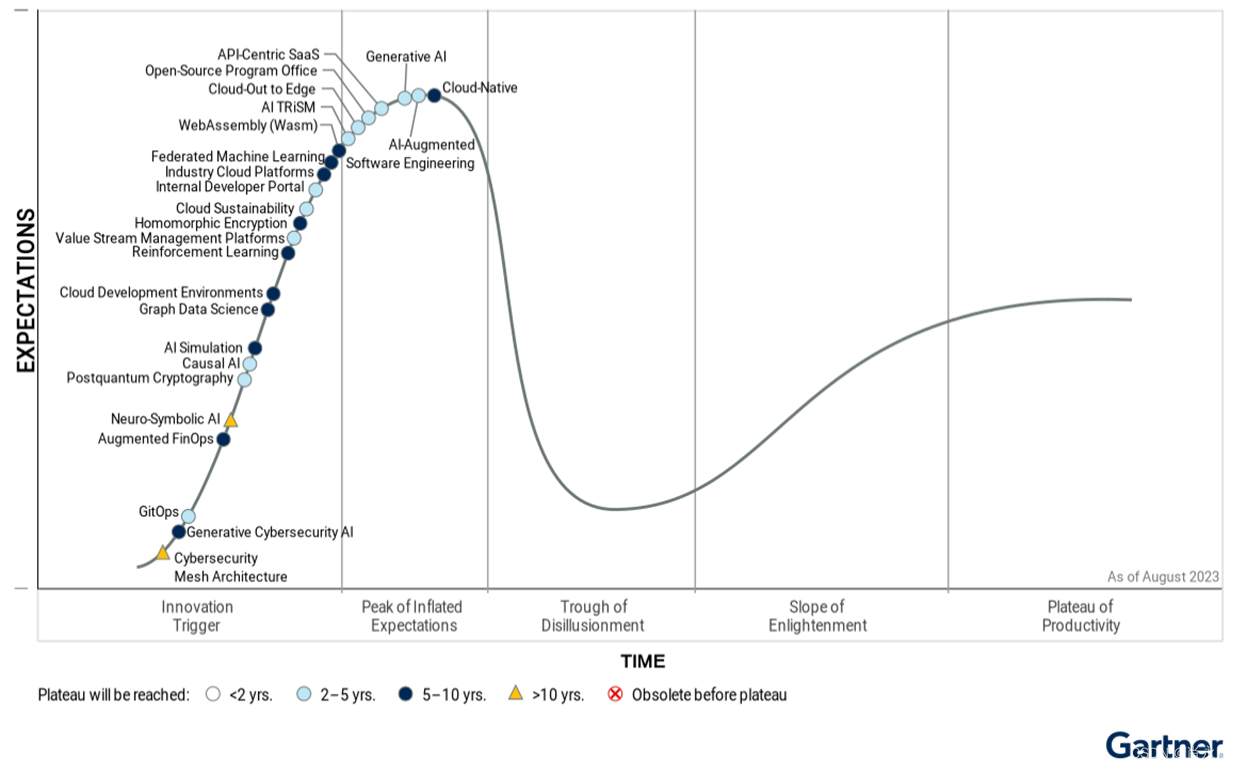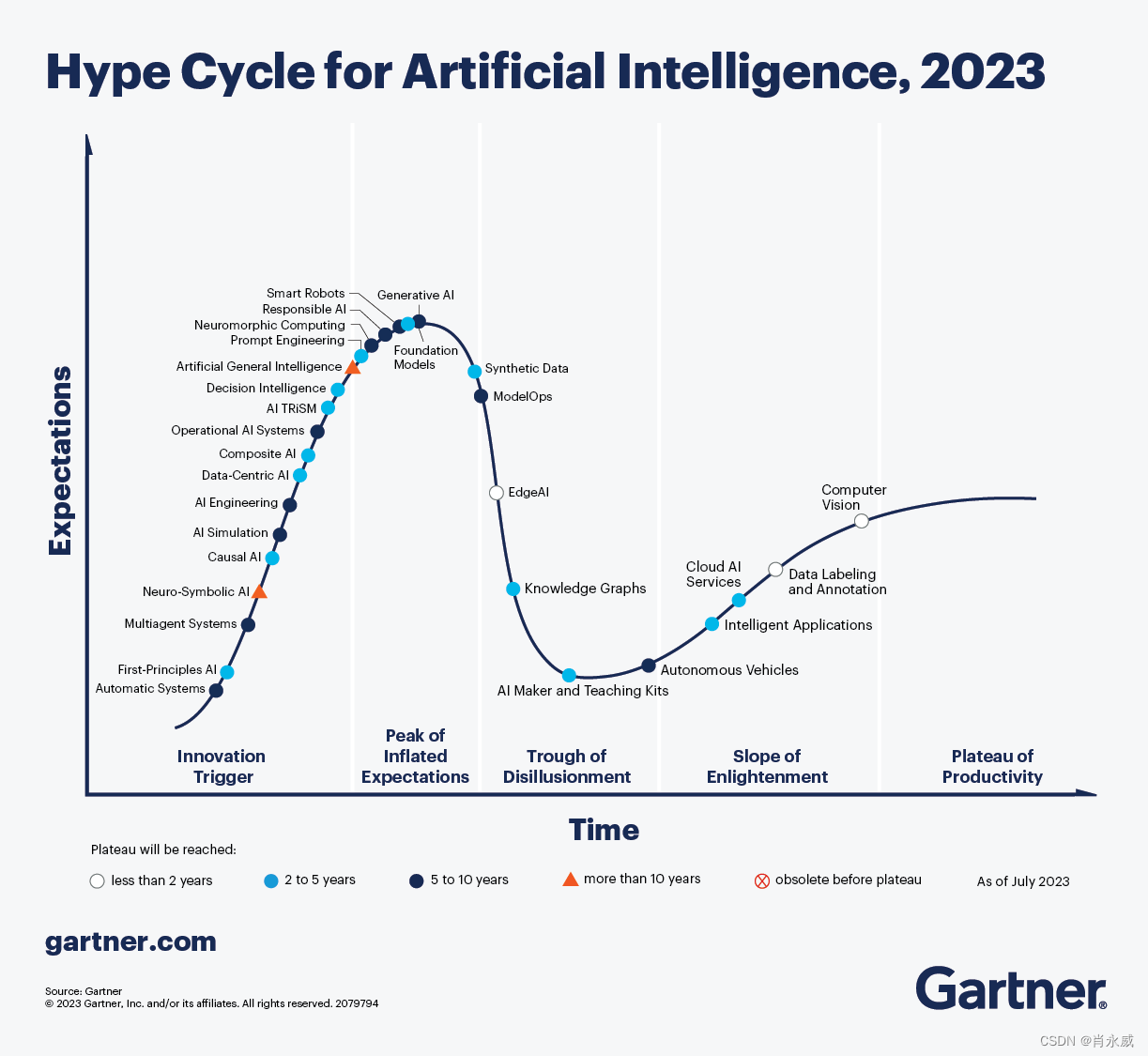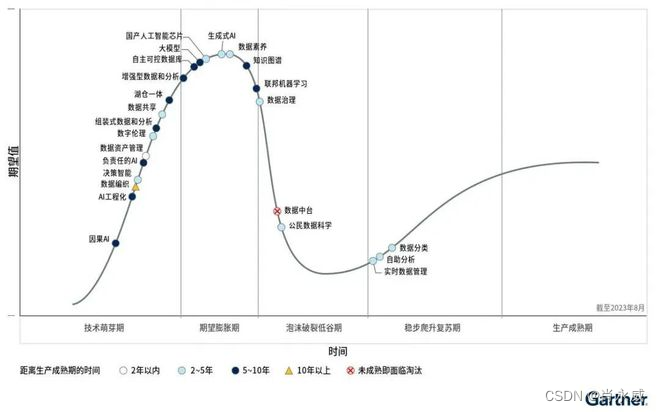1. Gartner places generative AI at the peak of the new technology maturity curve in 2023. Emerging artificial intelligence will have a profound impact on business and society.
According to the Gartner, Inc. Hype Cycle for Emerging Technologies 2023, generative artificial intelligence (AI) is at the expected peak of the hype cycle and is expected to realize transformational benefits within two to five years. Generative AI is included within the broader topic of emerging AI, a key trend on this Hype Cycle that is creating new opportunities for innovation.
Arun Chandrasekaran, Distinguished Vice President Analyst at Gartner, said: "The proliferation of many new AI technologies will have a profound impact on business and society. The scale of large-scale pre-training and AI base models, the proliferation of conversational agents, and the growth of generative AI applications. The surge heralds a new wave of labor productivity and machine creativity."
The Hype Cycle for Emerging Technologies is unique among Gartner Hype Cycles because it distills key insights from the more than 2,000 technologies and application frameworks Gartner profiles each year into a concise set of "must know" emerging technologies. These technologies have the potential to deliver transformative benefits over the next two to ten years (see Figure 1).

“While all eyes are now on artificial intelligence, CIOs and CTOs must also turn their attention to other potentially transformative technologies,” said Gartner Vice President Analyst Melissa Davis. of emerging technologies." "This includes technologies that enhance the developer experience, drive innovation through the ubiquitous cloud, and deliver human-centered security and privacy."
Davis added: “Because technologies in the Hype Cycle are still in their early stages, there is significant uncertainty about how they will develop. The deployment of such emerging technologies is riskier, but for early adopters There could be greater good.”
Four major themes in emerging technology trends
-
Emerging AI: In addition to generative AI, several other emerging AI technologies offer significant potential for enhancing digital customer experiences, making better business decisions, and building sustainable competitive advantage. These techniques include AI simulation, causal AI, federated machine learning, graph data science, neurosymbolic AI, and reinforcement learning.
-
Developer Experience (DevX): DevX refers to all aspects of a developer's interaction with the tools, platforms, processes, and people who develop and deliver software products and services. Enhancing DevX is critical to the success of most enterprise digital initiatives. It’s also critical to attracting and retaining top engineering talent, maintaining team morale, and ensuring work is motivating and rewarding.
Key technologies that enhance DevX include AI-enhanced software engineering, API-centric SaaS, GitOps, internal developer portals, open source project offices, and value stream management platforms. -
Popularization of cloud: In the next 10 years, cloud computing will develop from a technological innovation platform to an important driving force for widespread business innovation. To achieve this widespread adoption, cloud computing has become more fragmented and will focus on vertical industries. Maximizing the value of cloud investments requires automated operational scaling, access to cloud-native platform tools, and adequate governance.
Key technologies supporting pervasive cloud include enhanced FinOps, cloud development environments, cloud sustainability, cloud native, cloud to edge, industry cloud platforms and WebAssembly (Wasm). -
Human-centered security and privacy: Humans remain the primary cause of security incidents and data breaches. Organizations can become resilient by implementing a human-centered security and privacy program that embeds security and privacy structures into the organization's digital design. Many emerging technologies enable businesses to create a culture of mutual trust and shared awareness of risk in decision-making across many teams.
Key technologies supporting the expansion of human-centered security and privacy include AI TRISM, cybersecurity mesh architecture, generative cybersecurity artificial intelligence, homomorphic encryption, and post-quantum cryptography.
2. Generative AI and the innovations surrounding it are dominant and transformative.
The 2023 Gartner Artificial Intelligence (AI) Hype Cycle™ identifies innovations and technologies that can deliver significant, even transformative, benefits while also addressing the limitations and risks of error-prone systems. AI strategies should consider which ones offer the most credible investment cases.
Afraz Jaffri, principal analyst at Gartner, said: “There are many innovations in the AI Hype Cycle that deserve special attention and will become mainstream adoption within two to five years, including generative AI and decision intelligence. Early adoption of these innovations will Delivering significant competitive advantages and mitigating issues associated with using AI models in business processes."
Two types of GenAI innovation dominate
Generative AI is dominating the AI conversation, using systems like ChatGPT to increase developer and knowledge worker productivity in very real ways. This is causing organizations and industries to rethink their business processes and the value of their human resources, pushing GenAI towards the peak of over-expected expectations on the technology hype cycle.
Gartner now sees the generative AI movement as having two aspects on the path toward more powerful AI systems:
- GenAI will drive innovation.
- Innovations that will drive GenAI progress.

Generative AI will drive innovation
Generative AI impacts business as it relates to content discovery, creation, authenticity and regulation. It also has the ability to automate human work as well as customer and employee experience.
Key technologies that fall into this category include:
-
Artificial General Intelligence (AGI) is the (currently hypothetical) intelligence of machines that can perform any intellectual task that humans can perform.
-
AI engineering is the foundation for enterprises to deliver AI solutions at scale. This discipline creates coherent enterprise development, delivery and operational systems based on artificial intelligence.
-
Autonomous systems are self-managing physical or software systems that perform domain-defined tasks and have three basic characteristics: autonomy, learning, and agency.
-
Cloud AI services provide AI model building tools, APIs for pre-built services, and related middleware to support building/training, deploying, and using machine learning (ML) models that run as cloud services on pre-built infrastructure.
-
Composite artificial intelligence refers to the combined application (or fusion) of different artificial intelligence technologies to improve learning efficiency and broaden the level of knowledge representation. It solves a wider range of business problems in a more effective way.
-
Computer vision is a set of technologies that involves capturing, processing, and analyzing real-world images and videos to extract meaningful contextual information from the physical world.
-
Data-centric AI is an approach that focuses on enhancing and enriching training data to drive better AI outcomes. Data-centric AI also addresses data quality, privacy, and scalability issues.
-
Edge AI refers to the use of artificial intelligence technology embedded in non-IT products, IoT endpoints, gateways and edge servers. It covers use cases for consumer, commercial and industrial applications such as autonomous vehicles, enhanced medical diagnostic capabilities and streaming video analytics.
-
Intelligent applications use learning to adapt to respond autonomously to people and machines.
-
Model Operations (ModelOps) focuses on end-to-end governance and lifecycle management of advanced analytics, artificial intelligence, and decision-making models.
-
Operational AI Systems (OAISys) enables the orchestration, automation, and scaling of production-ready, enterprise-grade AI, including machine learning, DNN, and generative AI.
-
Just-in-time engineering is the discipline of providing input to generative artificial intelligence models in the form of text or images to specify and constrain the set of responses the model can produce.
-
Intelligent robots are artificial intelligence-driven, often mobile machines designed to perform one or more physical tasks autonomously.
-
Synthetic data is a type of data that is artificially generated rather than obtained from direct observations of the real world.
Innovations Driving Advances in Generative AI
"Generative AI exploration is accelerating thanks to the popularity of stable diffusion, mid-range, ChatGPT and large language models. End-user organizations in most industries are actively experimenting with generative AI," said Svetlana Sular, vice president analyst at Gartner .
“Technology vendors form generative AI groups to prioritize the delivery of generative AI applications and tools. 2023 will see the emergence of numerous startups innovating with generative AI, and we expect this to grow. Some governments are evaluating The impact of generative artificial intelligence and preparing for regulations.”
Key technologies that fall into this category include:
-
Artificial intelligence simulation is the combined application of artificial intelligence and simulation technology to jointly develop artificial intelligence agents and simulation environments that can train, test and even deploy artificial intelligence agents.
-
Artificial Intelligence Trust, Risk and Security Management (AI TRiSM) ensures AI model governance, trustworthiness, fairness, reliability, robustness, validity and data protection.
-
Causal AI identifies and exploits causal relationships, moving beyond correlation-based predictive models toward AI systems that can prescribe actions more effectively and act more autonomously.
-
Data Labeling and Annotation (DL&A) is a process of further classifying, segmenting, annotating and enhancing data assets to enrich the data for better analytics and artificial intelligence projects.
-
First principles artificial intelligence (FPAI) (also known as physical information artificial intelligence) integrates physical and simulation principles, control laws and domain knowledge into artificial intelligence models. FPAI extends artificial intelligence engineering to complex systems engineering and model-based systems
-
The base model is a large parameter model, trained on a wide range of data sets in a self-supervised manner.
-
Knowledge graphs are machine-readable representations of the physical and digital world. They include entities (people, companies, digital assets) and their relationships that follow a graph data model.
-
A multi-agent system (MAS) is an artificial intelligence system composed of multiple independent (but interactive) agents, each capable of sensing the environment and taking action. Agents can be artificial intelligence models, software programs, robots, and other computational entities.
-
Neurosymbolic AI is a form of composite AI that combines machine learning methods and symbolic systems to create more powerful and trustworthy AI models. It provides reasoning infrastructure that can solve a wider range of business problems more efficiently.
-
Responsible AI is an umbrella term for making appropriate business and ethical choices when adopting artificial intelligence. It encompasses organizational responsibilities and practices that ensure proactive, responsible, and ethical AI development and operations.
3. Gartner releases China’s data analysis and artificial intelligence technology maturity curve in 2023
Gartner predicts that by 2026, more than 30% of white-collar jobs in China will be redefined, and the skills to use and manage generative AI will be very popular.
Gartner's 2023 Hype Cycle for Data Analytics and AI in China reveals four basic themes related to data, analytics and AI in China: China data strategy that prioritizes business results, regional data and analytics and AI ecosystem, and data middle platform The collapse of , and artificial intelligence becoming a new symbol of national power.

data weaving
Data weaving is a design framework for obtaining flexible and reusable data pipelines, services and semantics, involving data integration, active metadata, knowledge graphs, data profiling, machine learning and data classification. Data weaving subverts the existing dominant approach to data management. It is no longer "tailor-made" for data and use cases, but "observation first and then use".
Zhang Tong, senior research director at Gartner, said: "The emergence of data, analytics and AI use cases, as well as rapidly changing data security regulations, have led to the complexity and uncertainty of data management in China. Data weaving can make full use of sunk costs while also Provide prioritization and cost control guidance for new spending on data management infrastructure.”
Assembled data and analytics
Assembled data and analytics (D&A) leverages container- or business microservices-based architecture and data weaving concepts to assemble existing assets into flexible, modular, and user-friendly data analytics and artificial intelligence (AI) capabilities. This technology can use a series of technologies to transform data management and analysis applications into data analysis and AI components or other application modules with the support of low-code and no-code capabilities, and support adaptive and intelligent decision-making.
Facing the rapidly changing business environment, Chinese enterprises and institutions need to improve their agility and speed up the output of insights. Assembled D&A helps enterprise organizations use modular data and analysis capabilities to integrate multiple insights and reference information into various measures to avoid fragmented development. Enterprise organizations can further improve delivery flexibility by assembling or reorganizing D&A capabilities to cope with different usage scenarios.
Reference:
What's New in Artificial Intelligence from the 2023 Gartner Hype Cycle , August 17, 2023
Gartner Places Generative AI on the Peak of Inflated Expectations on the 2023 Hype Cycle for Emerging Technologies , August 16, 2023
Gartner releases 2023 China Data Analytics and Artificial Intelligence Intelligent technology maturity curve , 2023-08-31